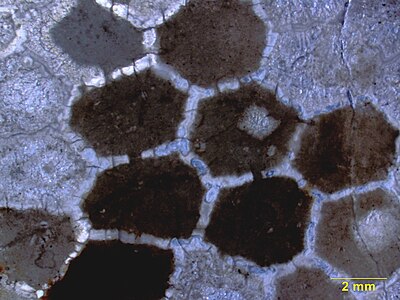Favosites
| Favosites | |
|---|---|

| |
| Favosites sp. from the Upper Ordovician of southern Indiana | |
| Scientific classification | |
| Domain: | Eukaryota |
| Kingdom: | Animalia |
| Phylum: | Cnidaria |
| Class: | †Tabulata |
| Family: | †Favositidae |
| Genus: | †Favosites Lamarck 1816 |
| Type species | |
| F. gothlandicus | |
| Species | |
|
See text | |
| Stereo image | |||
|---|---|---|---|
| |||
| |||
| |||
| |||
| More polished Favosites fossil. | |||
Favosites is an extinct genus of tabulate coral characterized by polygonal closely packed corallites (giving it the common name "honeycomb coral").[1] The walls between corallites are pierced by pores known as mural pores which allowed transfer of nutrients between polyps. Favosites, like all coral, throve in warm sunlit seas, forming colourful reefs, feeding by filtering microscopic plankton with their stinging tentacles.[2] The genus had a worldwide distribution from the Late Ordovician to Late Permian.[3]
Species
The following species of Favosites have been described:[3]
- F. abnormis
- F. adaverensis
- F. afghanicus
- F. antiquus
- F. bowerbanki
- F. burkhanensis
- F. desolatus
- F. exilis
- F. fallax
- F. favosiformis
- F. favosus
- F. fusiforme
- F. goldfussi
- F. gothlandicus
- F. hisingeri
- F. ingens
- F. intricatus
- F. issensis
- F. jaaniensis
- F. kalevi
- F. lichenarioides
- F. mirandus
- F. multicarinatus
- F. oculiporoides
- F. permica
- F. petropolitana
- F. praemaximus
- F. privatus
- F. serratus
- F. subfavosus
- F. subforbesi
Gallery
-
Sagittal cross-section of Favosites, showing communication pores between the corallites.
Upper Ordovician of southern Indiana
References
Categories:
- Tabulata
- Prehistoric Anthozoa genera
- Paleozoic animals of North America
- Fossils of Georgia (U.S. state)
- Paleozoic animals of South America
- Silurian Argentina
- Fossils of Argentina
- Silurian Paraguay
- Fossils of Paraguay
- Devonian Colombia
- Fossils of Colombia
- Floresta Formation
- Late Ordovician first appearances
- Permian genus extinctions
- Jeffersonville Limestone
- Paleontology in New Jersey
- Paleozoic life of Ontario
- Paleozoic life of British Columbia
- Paleozoic life of Manitoba
- Paleozoic life of New Brunswick
- Paleozoic life of the Northwest Territories
- Paleozoic life of Nunavut
- Paleozoic life of Quebec
- Paleozoic life of Yukon
- Fossil taxa described in 1816
- Anthozoan stubs
- Prehistoric cnidarian stubs



